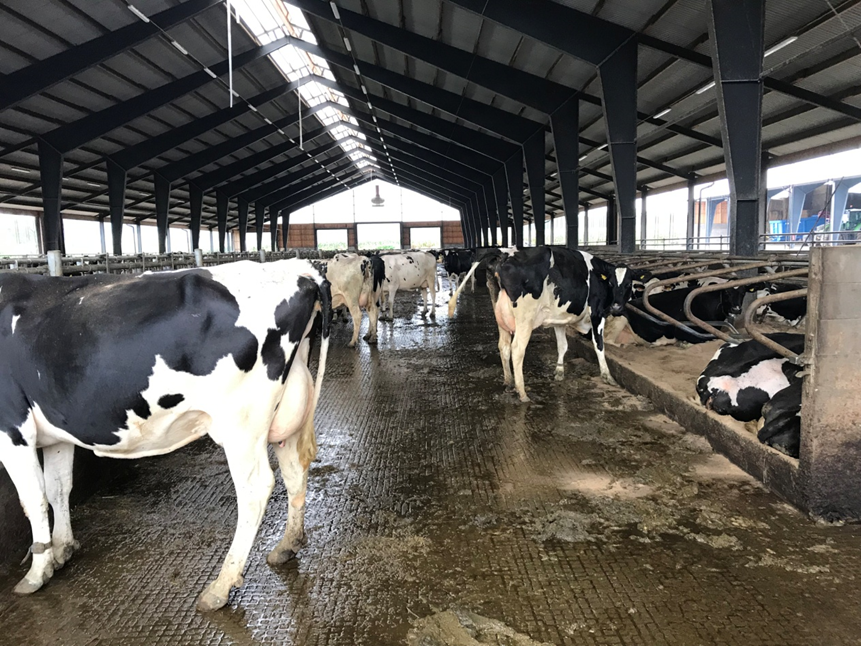News
Achieving your Breeding and Fertility Goals
Breeding Goals
For most dairy herdowners who are running a compact Spring calving system, the main breeding goal is to breed enough high-quality replacements and have them born in the first month of the calving season. Using some or all sexed semen will allow for more selective breeding but will also allow more beef AI to be used from the start, minimising the number of dairy bull calves born and increasing the number of saleable, higher value dairy beef calves.
Fertility Goals
Too many cows left to calve at this time of year are a complication that most farmer would like to avoid. Achieving a high six-week calving rate and a low empty rate after a max of 12 weeks breeding will keep these late calvers to a minimum. Caving 70% of your cows in the first 6 weeks combined with all your heifers will get you to the magic figure of 90% calved in 6 weeks.
Tasks for early April
Identify and treat cows with infections.
Should the whole herd be scanned or metrichecked? The answer here depends on the prevalence of health issues like retained afterbirths, milk fever, displaced stomachs and the level of negative energy balance as indicated by how low the protein dropped in the milk and the body condition score of the cows. The answer also depends on the availability of accurate records for the afore mentioned health issues.
If the herd had a relatively trouble free Spring and the cows are in reasonably good body condition, only examining and treating (if necessary) cows that had any issue or are in low body condition will be sufficient. If record keeping is poor and/or there was a high prevalence of health issues like retained afterbirths or milk fevers, a whole herd scan or metricheck is definitely worthwhile doing to get any cows with uterine infections identified and treated early.
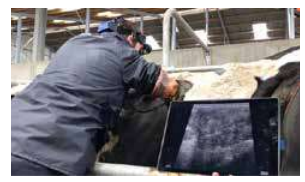
Ultrasound scanning a cow
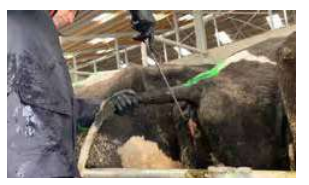
Metichecking a cow
Take action on cows struggling for body condition
The target body condition score for cows prebreeding is 2.75 to 3.0. Cows that drop below 2.75 will be slower to come bulling and will have lower conception rates. Once a day milking is a great option for these cows. Milk them once a day and feed them twice a day in the parlour. By milking them once a day you will decrease their output but the energy taken in will stay the same. They will cycle quicker and have a better chance of going in calf and being retained in the herd.
Mind the later calvers
The later calvers face some challenges that cows that calve earlier may not face. They can easily become over conditioned from a prolonged dry period. Cows in BCS of 3.5 or greater will be at a higher risk of milk fever and will eat less before and after calving, making them more at risk of a more sever negative energy balance and of developing a displaced stomach from reduced dry matter intake and poor rumen fill. Do not restrict these cows before calving as it will worsen the situation. 1 to 2 kgs of a simple mix like oats and soya or a specialised Precalving mix will reduce the NEB before calving and allow them to start on 4kg straight after calving without any issue.
Ensure they are getting their precalving minerals. As mentioned they may be at an even greater risk of milk fever making the role of the precalving mineral even more important. These can be fed with the ration to ensure intake.
All dairy cows have reduced dry matter intake in the weeks post calving. However, in April, hopefully, grass availability will be good and intakes of grass will be high for cows calved 6+ weeks and concentrates in the parlour can be reduced in line with increased intakes of grass. This is where the late calvers can struggle as they are only taking in 12 to 13kg of dry matter after calving but their output can increase quickly. Again, once a day milking for the first couple of weeks is a great option. Obviously, only practice once a day milking in cows you wish to retain in the herd.
Mind the maidens to ensure high conception rates are achieved.
It has been another very challenging Spring to get maidens out to grass. Maidens that have been out will not have achieved the growth rates expected from being out on Spring grass. If you are concerned about whether your maidens are up to target weight, weight them. The target weight for maidens at breeding depends on their maintenance figure within their EBI index. If heifers are behind target weight, take action by getting the lighter heifers out and feeding some concentrates if necessary. Heifers that will not be on target weight for breeding should not get sexed semen.
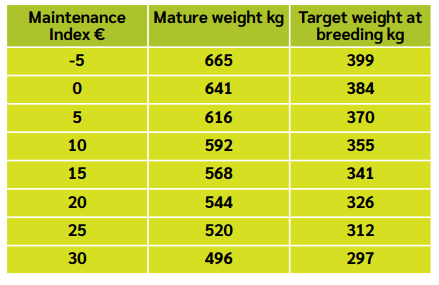
Guidelines for successful use of Sexed Semen
Sexed semen allows you to select your best performing, highest genetic merit cows and heifers to breed replacement heifer calves from. Also, using sexed semen increases the number of high value beef calves produced in the herd. Sexed semen straws are on average 90% purity. This means that for every 10 calves born on average 9 will be female. Sexed semen straws have a lower number of sperm than conventional semen straws. All domestic Munster Bovine sexed semen are produced with 4 million cells per straw to maximise fertility. Sexed semen is a vulnerable product: it has undergone a sorting process in the laboratory. This reduces its viability compared to conventional semen meaning inseminating cows early should be avoided as the semen will not last long enough in the cow. During sexing, the sperms cells go through a natural process called capacitation which renders them capable of fertilizing an egg. For conventional semen this happens in the cow and takes approximately 10 hours. The fact that sexed semen has already capacitated allows sexed semen to be used later in the heat. Sexed semen trials in Ireland have demonstrated a relative conception rate of 80% - if achieving 60% conception in cows with conventional, on average 48% should be achieved with sexed semen. While successful use of sexed semen is a challenge, excellent performance can be achieved by following some simple rules.
COW SELECTION
· Cows need to be at least 50 to 60 days calved at time of AI and should be clean and cycling regularly beforehand.
· Younger cows have higher conception rates (1st to 4th calvers) - Careful with some 1st calvers if BCS is low and they have not coated off yet.
· Body condition is critical - 3.0 or greater is ideal.
· Cows with no issues at calving or since calving – difficult calving, milk fever, retained afterbirth, uterine infection, ketosis, lameness, mastitis etc
· Energy balance is crucial – watch the bulk tank for any drop in % protein & volume. Ensure cows are fully fed particularly during periods of bad weather.
HEIFER SELECTION
· Your heifers will have higher conception rates than your cows making them better candidates for sexed semen.
· You will be breeding more replacements from your highest genetic merit stock.
· Heifer calves will also be easier calved – further reducing calving difficulty for your maidens.
· Cycling regularly – Avoid its use on heifers on their 1st or 2nd cycle.
· Heifers need to be above their target weight and in good body condition.
· Nutrition – maximise intakes during breeding and for the following month.
ONLY USE SEXED SEMEN EARLY IN THE BREEDING SEASON
Use sexed semen early in the breeding season, within the first three weeks and preferably for the first 10 days. Consider starting the breeding season a week earlier to accommodate any repeats early in the mating season and maintain a high six week calving rate.
USE AN ADEQUATE SIZE TEAM OF BULLS
Field fertility can vary between bulls following the sexing process and it is advisable to use a team of sexed bulls.
Timing of AI
As mentioned earlier, sexed semen will not last as long as conventional semen in the cow. Avoid use in cows/heifers that are actively showing signs of heat as you are too early.
Sexed semen can be successfully used later in a cows heat than conventional semen due to the fact that it is already capacitated and is ready to fertilise.
If your technician is coming once a day in the morning, any cow that has started standing heat since the time he left and 12 hours before the next visit the same time the next day is suitable for sexed. Select enough cows for the straws you intend to use so that you have choice and will get the timing right which is critical. Twice a day AI will increase the number of cows available to use sexed on. If DIY follow the guidance below. Also ensure straws are being loaded into prewarmed guns and kept warm until going into the cow.
Synchronisation and sexed
Modern synchronisation programmes that end in fixed time AI have an important role to play as they synchronise ovulation to the time of insemination (no need for heat detection). It also allows a group of heifers or cows to be inseminated early in the season, increasing the submission rate. Repeats will have more opportunities to go in calf.
Related Articles
Herd Health Meetings with Munster Bovine Vets this Autumn – Common Threads and Lessons Learned During 2023.
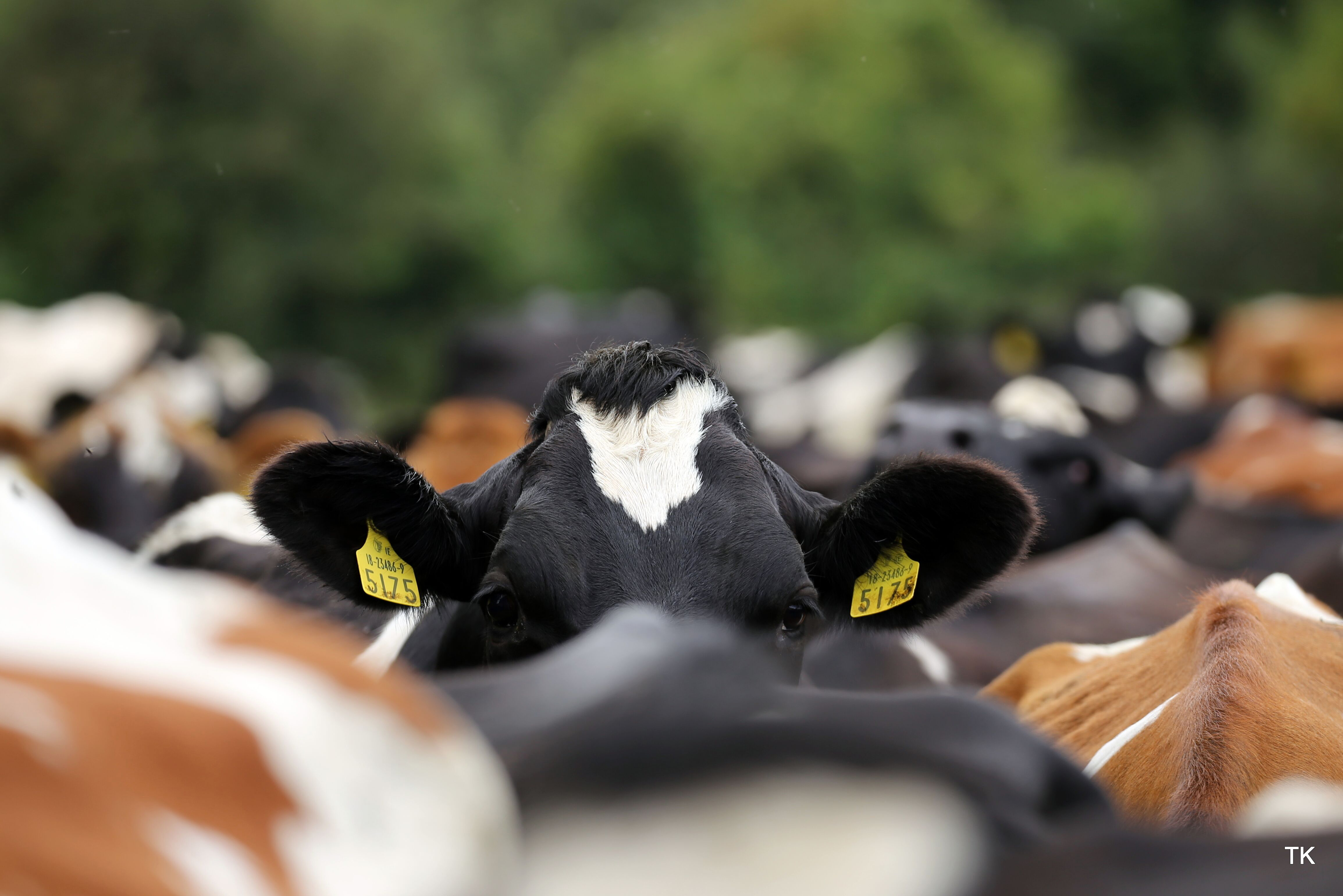
Herd Health Decisions and Tasks for the Dry Period

Munster Bovine Launches New Website

Successful Cow Housing System Guide
